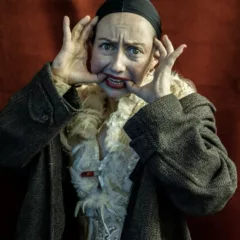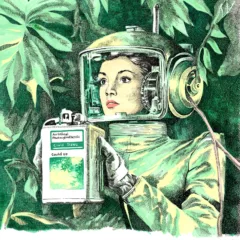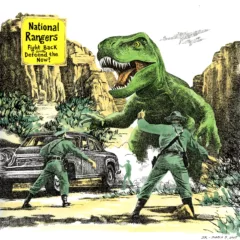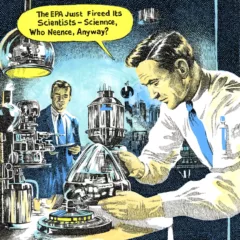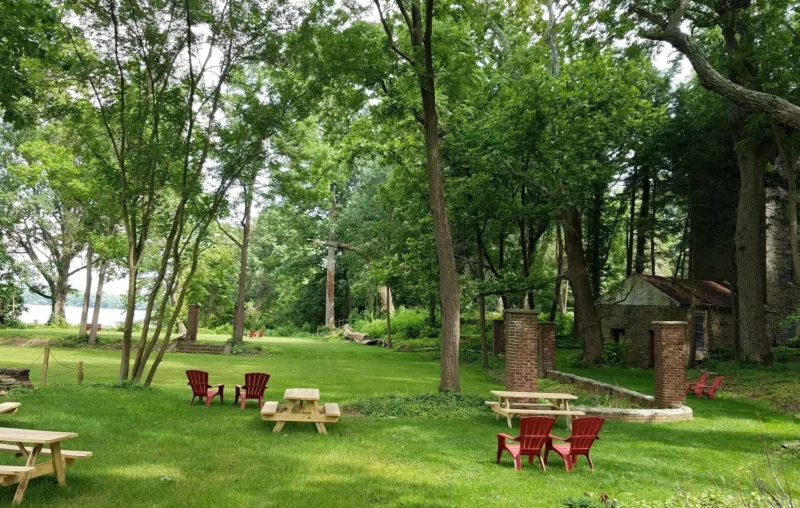
It is 1:00 PM on Saturday, August 5, 2023. I am seated in the flat, grassy area referred to as the Tennis Court, on the Glen Foerd estate. I am waiting for the estate’s garden gnome to appear. I have not nibbled an amanita or any other hallucinogenic mushroom. I am here for the world premiere of “Gnome Core, An Experimental Art Performance” by Alex Tatarsky.
How did I get here? Well, technically, via I-95. Depending on traffic, Glen Foerd is about a half hour drive north of Center City, Philadelphia. Along the way you will traverse the temporary replacement span of the overpass that burned and collapsed after a gasoline tanker truck overturned and caught fire on an off-ramp. You will probably not realize it. From the roadway, the quick and innovative repairs are undetectable. If only we could employ that can-do attitude to other petroleum-based problems in the world.
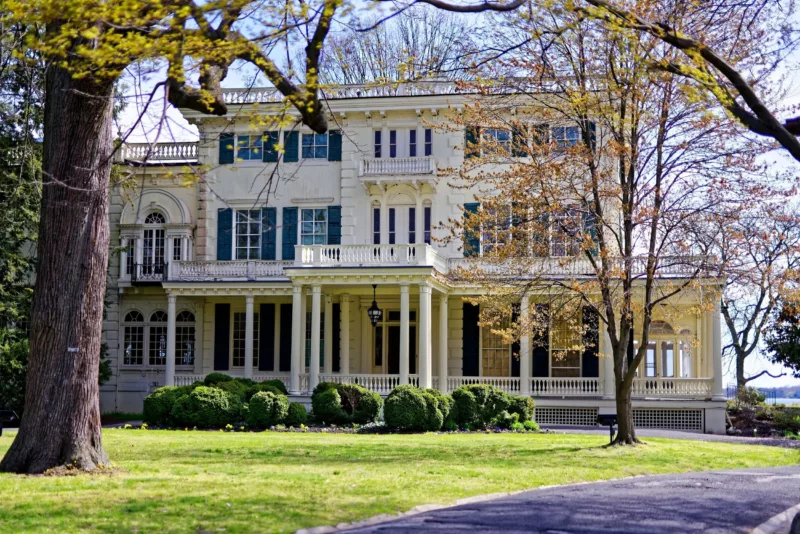
From I-95, take exit 32. You will pass several condominium communities. You may notice that one has its own security guard booth. I mention this because the Glen Foerd estate, situated on a stunning 18-acre parcel along the Delaware River, was snatched from the excavator jaws of condo-minded developers by plucky neighbors in the 1980s. The grounds are now a public park, and the buildings are owned and operated by the Glen Foerd Conservation Corporation and the Fairmount Park Commission. It is not your typical house museum. Part of its operating revenue comes from wedding and event rentals, which is a continuation of the survival strategy employed by the visionary neighbors.
Also, this house museum likes to look at itself, both past and present. Since 2015, it has sponsored a visual artist-in-residence program that encourages recipients to engage with the estate’s history and surroundings. This broad-mindedness expanded even more recently. With funding from the National Endowment for the Arts, the program supported three artist proposals, and the categories of performance and teaching artist were added to the 2022-23 term. The recipient in the performance category is Alex Tatarsky, an actor, a clown, a forager of edible plants and historical data, a socially conscious and subversive improvisational comic, and a linguistic gamester.
At 1:05 PM the door of the stone Water Tower opens. A slender person emerges, squinting, sporting a baseball hat and red conical cap, and wearing a distressed pinafore over weathered pants and a black shirt. They are carrying a guitar. A woven rucksack is slung over their shoulders.
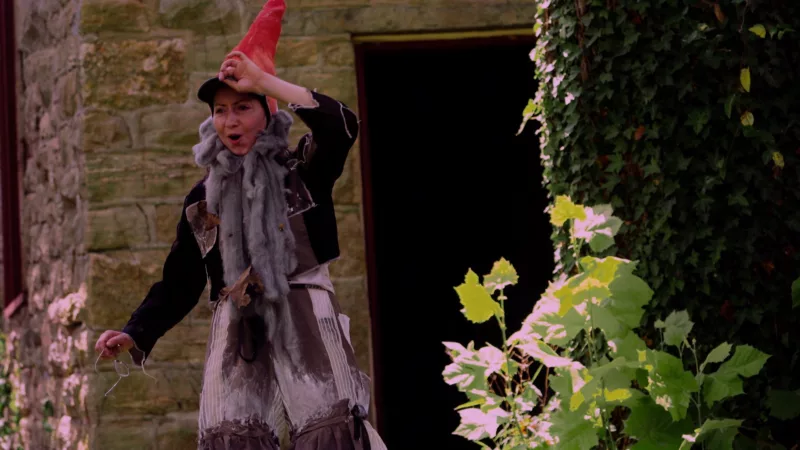
We learn the gnome is a hermit, employed by the estate, and hasn’t seen people for seven years. “SEVEN YEARS!” They weep a bit, rage a bit, overwhelmed by the enormity of the experience. The gnome asks whether we’ve heard of garden gnomes. The audience is shy, and the gnome has to ask again. When they get a smattering of ‘yeses’ the gnome declares, “Oh, so you GKNOWME?” We hear the silent “g” and “k” and smile. “I workshopped that opening for SEVEN YEARS!” we’re told.
We learn that seven years was the typical length of employment for people hired to live as ornamental hermits and enliven the gardens of wealthy estate owners. Their terms of employment required them to not cut their hair, beards or fingernails during their tenure. This explanation is movingly illustrated by our gnome applying a coating of short black bristles to their face and asking searching questions then answering them. “Do I regret the choices I’ve made? Yes!” And “Can I get you anything? Many things are edible,” they declare, picking at the ground and nibbling greenery.
Our gnome turns out to be quite a talker. They are wildly enamored of the natural world, but they are also worried about the state of things. You can tell from the nodding heads and murmurings of agreement that our hermit-gnome has a sympathetic audience. With daily reports about wildfires, floods, searing air and water temperatures, who isn’t worried?
(You might think that serious issues like those would not be good subjects for broad comedy and farce. You would be wrong. Tatarsky and I talked later about the tradition of Italian Commedia dell’ Arte and court jesters to entertain while telling truths. I learned that Tatarsky moved from New York to Philadelphia in 2015 to study clowning and physical theater at the Pig Iron Theatre School. Before that, they cut their intellectual teeth at Bard High School, an accelerated program where graduates receive an associate’s degree, and Reed College where they studied Russian literature and translation theory.)
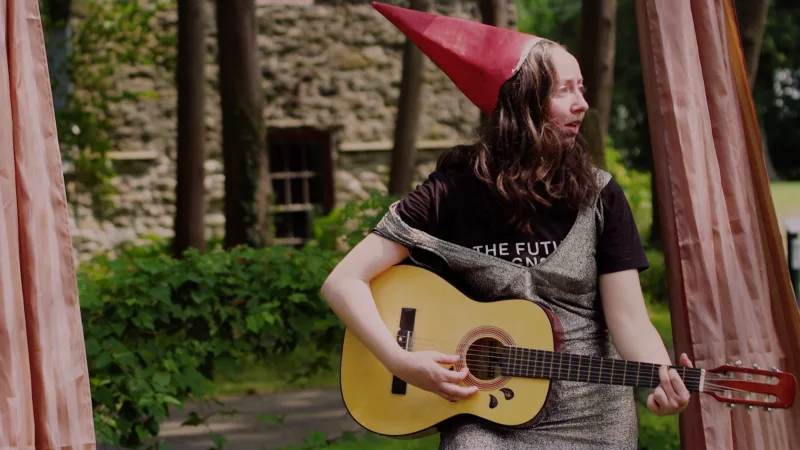
Back to the performance. We find out that the patrons and their guests in days of yore would ask their hermits searching questions. We are invited to ask questions. Someone shouts out, “What brings you joy?” Our hermit’s response includes this nugget: “You know what’s inside ‘joy’? ‘Oy!’” Another question: “What is your favorite color?” We learn that it is green, how could it be otherwise for someone who lives in a garden? Their answer contains the lump of comedic gold that the word ‘how’ contains the word ‘ow’ and we are treated to the many ways the world and our hermit are pained. A third question is more difficult. It is hard to hear and comprehend. Something about avian velocity. Our melancholic and incredulous hermit is undaunted by the convoluted query and proves to have the head and heart of an improviser. They answer with verve and a physical reenactment of avian demise in an unfair world.
This bit leads into a sad song with the guitar. Sitting on a jagged-topped pipe (talk about ow!) jutting out of the ground cover, strumming and singing, we come to understand that the hermit is not ready for the world to end. They rally and we are on the move. (The program note indicated that we would be meandering.) Next, as our gnome perches atop a brick wall, we are led in a group Minute Meditation, followed by a Laughing Meditation, which ends, predictably, with our entertainer weeping, embodying the sad clown paradox.
A small keyboard appears from the rucksack. We are now treated to a song about the earth burning, and we are called to action. “Don’t grin and bear it, grrrrrr and bury it!” and more riffs on the power of “grrr.” It is silly yet endearing.

Next, we are led to the hermit gnome’s outdoor studio. Here the story gets a bit scatological as they describe the difficulty of their artistic process. Suffice to say, some outer clothing is discarded, inner clothing is rearranged, and voilà, a bucket with a brown substance is produced. Some people bleed for their art. Others… but wait! There is a keen edge to this jape. Dipping a paintbrush into the bucket, brown letter by brown letter, the word “EARTH” is painted on a piece of cardboard. “Ohhhh,” we in the audience murmur. The gnome continues painting, obliterating the first and last letters and creating “ART.” “Ahhhh,” we enthuse. (I’m leaving out lots of things in the show – a catchy dance-song about a woozy flag and its stars, a romping gambol to return leaves to the lawn.)
Somewhere during the studio segment, we learn more about the hermit gnome’s backstory. Prior to their time as a garden hermit employed by the owning class to enliven the grounds, they attended an experimental dance workshop in Oslo, Norway. There, they were castigated for performing “object dances,” which is what it sounds like–dancing with props or things–and which we were treated to in this performance. They were also informed that speaking did a disservice to the art of dance, especially when a silly voice was used. The gnome hermit mimicked the instructor, accent and all: “If one must speak, it should be in a plain and direct manner.” Bemused by the Norwegian dance workshop leader’s asceticism, our hermit gnome recounted another case of high and low art confusion during the same trip when they came across a large sculpture of a gnome-like Santa holding a Christmas tree or buttplug in the center of a traffic circle in Oslo. The sculpture is by the American artist, Paul McCarthy.
This was not the only art world reference in the show. After stripping off their pinafore and shirt, we see they are wearing a t-shirt with one of Jenny Holzer’s “Truisms“ on it. While wearing the message “Abuse of power comes as no surprise,” they gave us a quick history lesson on the land and mansion. After the Lenape and before the mansion was built one property owner ran the Robin Hood Hotel, which also had a casino. Wealthy men would come to rest and gamble. Instead of taking and giving money away to the poor, as Robin Hood did, they would just keep taking and taking. Then we are told how the estate had two wealthy owners. Charles Macalester built the original mansion, and then Robert Foerderer renovated it, using the fortune he made from exploiting workers as a fine leather goods manufacturer. A take-away is that the process of tanning leather relies on the use of excrement. There’s that high and low dichotomy again.
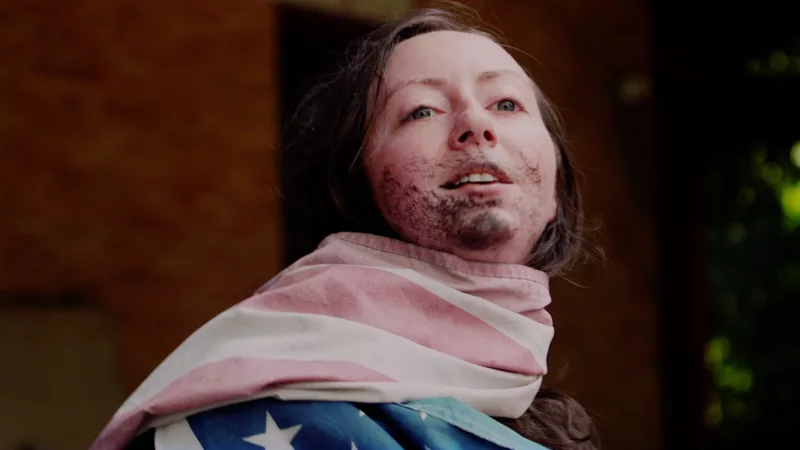
We follow the hermit gnome to an area where a small, curtained stage has been set up. A shimmery fancy costume is donned as well as a different pointed hat while we are told, “You can’t see me.” Props are unloaded from a crate, including a Christmas tree or buttplug, and a skull. Another song is sung. While we are considering the transience of life and the futility of pleasure in the vanitas tableau before us, our performer subverts that and unhinges the skull, pours a colorful cereal and bottle of milk into the cranium and proceeds to eat it with a spoon and a slight smile. (Later I find out that Alex thoroughly enjoyed the novelty of the repast. They grew up in a family that did not allow sugary cereals.)
For the last segment we are asked to wait by the side of the water tower. A few minutes pass, then Tada! A window opens and we see our hermit gnome is wearing a long gray beard wound around an orange gizmo. With a flourish, the beard is let down, Rapunzel-style, and we bid adieu to our garden hermit gnome, who truly did enliven our environment.
Alex Tatarsky was a canny choice to inaugurate the performance artist residency. Tatarsky introduced the inspiring character of the garden hermit gnome as a caretaker who tidies up our patch of Earth with a tender, subversive, impishness while acknowledging the difficult state of things. In other words, despite local and global adversities, the show must go on!
Speaking of that, I asked Tatarsky about their future plans. They told me they may return to Glen Foerd, perhaps to lead foraging tours (which they have done in the past as a character called the Apocalypse Housewife) or, maybe the garden hermit gnome will make another appearance. In the meantime, you can catch Tatarsky in “Sad Boys in Harpy Land” as part of the Philly Fringe Festival at Icebox Project Space from September 28-30.
Highlights from the Gnome Core performance on Sunday, August 6th can be viewed on a video loop during Glen Foerd’s ArtsFest on September 24th. The event is free, registration at the link. Check the website for more details.


